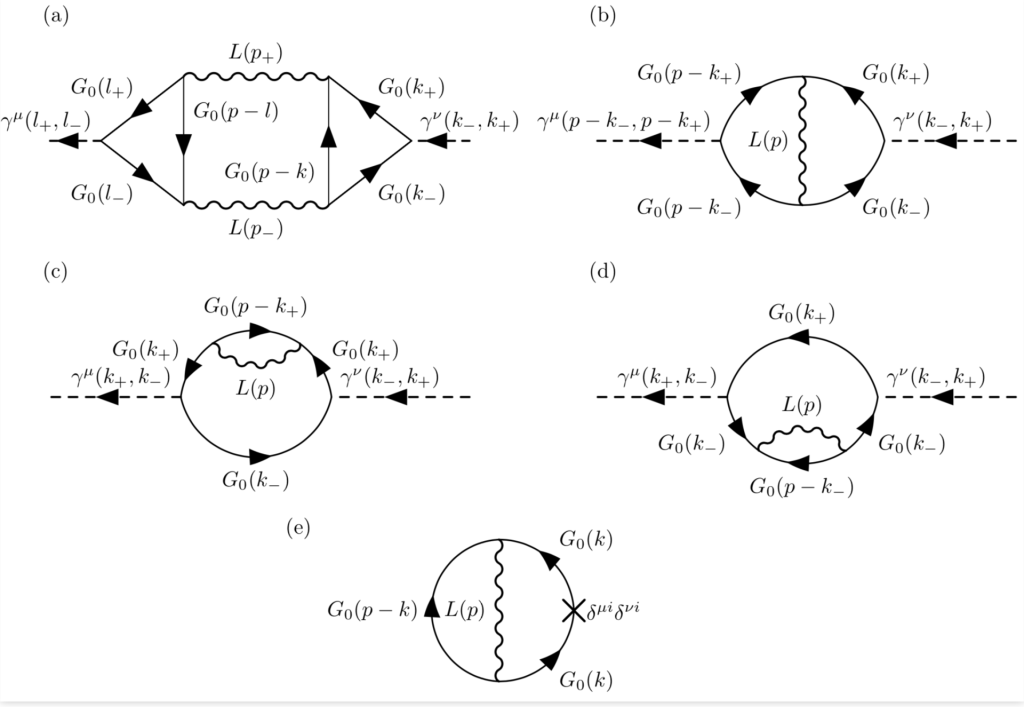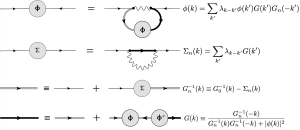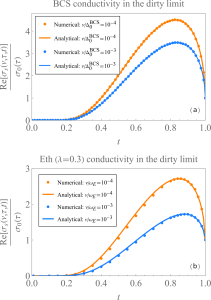My research in theoretical condensed matter physics focuses on two central themes: (i) superconductivity and (ii) quantum criticality. Below is a list of projects I have worked on within these subjects.
I. Superconductivity
- Fluctuation theory of superconductors.
 The above Feynman diagrams give the ultraclean fluctuation response in the normal-state of a Fermi superfluid. They are gauge invariant, have no Meissner effect, and the total electrical conductivity, in this ultra-clean limit, is due to only the final diagram. The first diagram is known as "Aslamazov-Larkin", the second diagram is known as "Maki-Thompson", and the third and fourth diagrams are referred to as the "Density of states" contribution. Phys. Rev. B 98, 184504 (2018).
The above Feynman diagrams give the ultraclean fluctuation response in the normal-state of a Fermi superfluid. They are gauge invariant, have no Meissner effect, and the total electrical conductivity, in this ultra-clean limit, is due to only the final diagram. The first diagram is known as "Aslamazov-Larkin", the second diagram is known as "Maki-Thompson", and the third and fourth diagrams are referred to as the "Density of states" contribution. Phys. Rev. B 98, 184504 (2018). - Eliashberg theory of superconductivity:
Eliashberg theory is an electron-phonon theory of superconductivity that incorporates a dynamical pairing function.
These are the self-consistent equations (in diagrammatic form) for Eliashberg theory. Phys. Rev. B 104, 014513 (2021). The pairing gap (phi) is frequency dependent, and this results in very interesting behaviour in the limit of weak electron-phonon interactions. In particular, differences between weak-coupling Eliashberg theory and BCS theory can be found in the respective electrical conductivities, which is shown in the above figure. Commun. Phys. 6, 54 (2023).
In particular, differences between weak-coupling Eliashberg theory and BCS theory can be found in the respective electrical conductivities, which is shown in the above figure. Commun. Phys. 6, 54 (2023). - Fulde-Ferrell superconductors:
Fulde-Ferrell (FF) and Larkin-Ovchinnikov (LO) superconductors have finite centre of mass momentum Cooper pairs. This type of inhomogeneous pairing usually occurs in the presence of an external magnetic field or a chemical potential imbalance between different spin species. Collective modes have important contributions in the superfluid response of such inhomogeneous systems.
This Feynman diagram shows one of the self-consistent equations to determine the collective modes (amplitude and phase modes) of a Fulde-Ferrell superfluid. Phys. Rev. B 95, 214501 (2017).
II. Spin liquids
- Three-dimensional quantum electrodynamics (QED3):
Spin liquids involve entanglement, fractionalization, and other many-body effects. The abelian spin liquid is a phase of matter described by gapless spinons interacting with a U(1) gauge field. This theory is known as QED3, and it forms a phase from which other spin liquid or antiferromagnetic states can emerge at the transition point. The phase transition from an abelian spin liquid to a Z2 spin liquid is descirbed by QED3--Gross-Neveu Yukawa. The above Feynman diagrams arise in the computation of the correlation exponent for this theory. PRB 99, 195135 (2019).
The phase transition from an abelian spin liquid to a Z2 spin liquid is descirbed by QED3--Gross-Neveu Yukawa. The above Feynman diagrams arise in the computation of the correlation exponent for this theory. PRB 99, 195135 (2019). - Monopole operators in QED3--Gross-Neveu Yukawa:
In continuum free space, Maxwell's theory of electromagnetism contains a vector potential which takes values on the real line. On a lattice, however, the vector potential is periodic, and so one can incorporate gauge-invariant additions of integer multiples of 2pi to the vector potential. This leads to the notion of flux-insertion (or monopole) operators. These operators are important as they can potentially render a phase transition unstable. Thus, studying their scaling dimensions is an important problem to consider. PRX 12, 031012 (2022).
